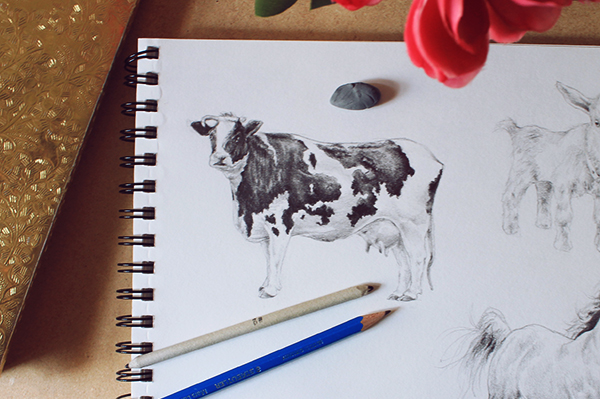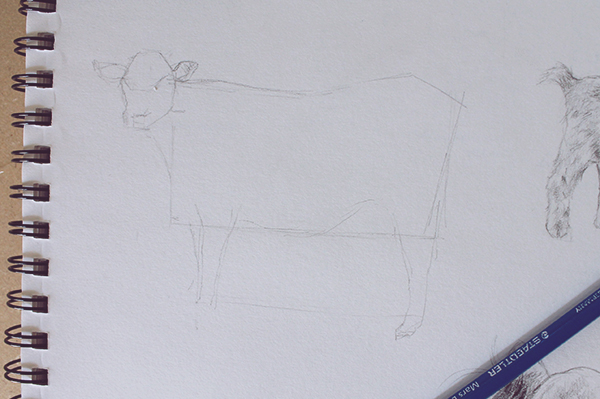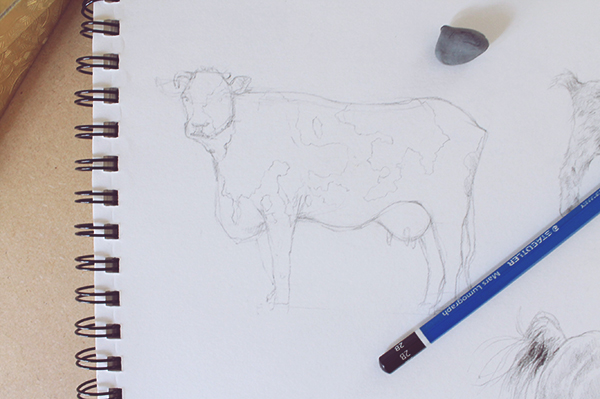When we think of farm animals, cows and pigs are some of the first that comes to mind. Learning to draw both animals at once will help you notice an interesting contrast between the shapes of these two animals, which can be useful the more you draw farm animals.

Follow along with this step-by-step tutorial to learn how to draw cows and pigs!
The pig resembles other common animals like the rabbit or the chicken, in the sense that they all have very curvaceous bodies and their basic structures can be summed up into a circle or oval. On the other hand, the cow has a much more angular shape. With these differences in mind, let’s get started and have a look at the process of drawing them in a realistic way.
How to draw pigs
Step 1:

First, we need to draw our initial sketch. The best basic shapes to start drawing a pig are circles and ovals.
Draw a circle for the face and a long horizontal oval for the body. Within this oval, draw a vertical oval at the back to help you find where the back legs will be placed, and a circle at the front, right below and slightly to the left of the face circle. These two shapes are important because they will help you work out the width of the front and back legs.
Continue the base sketch by drawing the features on the face, adding the tail and finishing drawing the legs.
Step 2:

Once you finish your basic lines and have a drawing of a pig, you can clean up your sketch by erasing the basic shapes we drew during the first step.
There are various breeds of pigs, we can generally say that the most well-known pigs are pink and present a smooth surface with soft features. With this knowledge, we know that the drawing will be mostly made up of very light tones of gray and there won’t be very dark areas, with the exception of the eyes. Therefore, we will use a 2B pencil for the entire drawing, without applying much pressure, in order to keep our pencil strokes light and soft.
Step 3:

Draw soft diagonal lines to simulate the fur (here’s more on how to draw fur) and shade the areas of shadow on the legs, the snout, the underbelly and inside the ears.
Step 4:

Continue to shade the whole body, legs, and face. Draw short and soft directional lines here and there, mostly in the areas of the torso where the darkest tones are located. This will give the impression of pig hair and give it a realistic look. Draw the darkest tones on the eyes and snout by applying more pressure to your 2B pencils.
How to draw realistic cows
Step 1:

Compared to pigs, cows have a much more angular shape. This is why the most fitting basic shape to start drawing it is a rectangle. Sketch where the face, ears, and legs will be placed and begin to find the body’s curves within the rectangle.
Step 2:

After you finish drawing the initial sketch, erase all unnecessary lines and begin to add some more details. Begin to find the cow’s curves within the original rectangle. Also, draw where its spots are located and begin to refine some of the details.
Step 3:

After you are completely done with the details, you can get started on the task of shading your drawing. For the cow, this is where we will begin to add all of the realism through shadows and its dark spots. You can start off by shading in a messy fashion as we will refine it all in the following steps.
Step 4:

The cow’s spots are very dark but keep in mind that they are not monotone. They have areas of deep darkness where the shadows are located, but the same spots present a lighter tone where the light hits. Keep this in mind when you use your 6B or 8B pencil to shade these areas.
Step 5:

Cows present a smooth surface. To achieve this soft and blended look, I recommend using a blending stump to smooth over the darker tones.

Share tips, start a discussion or ask one of our experts or other students a question.
No Responses to “Realistic Farm Animals: How to Draw Pigs and Cows”